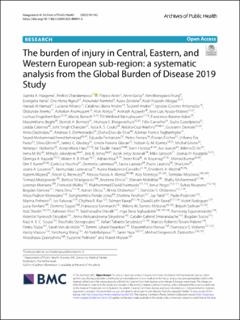| dc.contributor.author | Haagsma, Juanita A. | |
| dc.contributor.author | Charalampous, Periklis | |
| dc.contributor.author | Ariani, Filippo | |
| dc.contributor.author | Gallay, Anne | |
| dc.contributor.author | Iburg, Kim Moesgaard | |
| dc.contributor.author | Kisa, Adnan | |
| dc.contributor.author | Nena, Evangelia | |
| dc.contributor.author | Ngwa, Che Henry | |
| dc.contributor.author | Kisa, Sezer | |
| dc.contributor.author | Rommel, Alexander | |
| dc.contributor.author | Zelviene, Ausra | |
| dc.contributor.author | Majdan, Marek | |
| dc.contributor.author | Europe Injuries Collaborators, GBD 2019 | |
| dc.date.accessioned | 2022-08-19T12:17:49Z | |
| dc.date.available | 2022-08-19T12:17:49Z | |
| dc.date.created | 2022-05-22T21:20:20Z | |
| dc.date.issued | 2022-05-20 | |
| dc.identifier.citation | Archives of Public Health. 2022, 80 (142), . | en_US |
| dc.identifier.issn | 2049-3258 | |
| dc.identifier.uri | https://hdl.handle.net/11250/3012707 | |
| dc.description.abstract | Background: Injury remains a major concern to public health in the European region. Previous iterations of the Global Burden of Disease (GBD) study showed wide variation in injury death and disability adjusted life year (DALY) rates across Europe, indicating injury inequality gaps between sub-regions and countries. The objectives of this study were to: 1) compare GBD 2019 estimates on injury mortality and DALYs across European sub-regions and countries by cause-of-injury category and sex; 2) examine changes in injury DALY rates over a 20 year-period by cause-of-injury category, sub-region and country; and 3) assess inequalities in injury mortality and DALY rates across the countries.
Methods: We performed a secondary database descriptive study using the GBD 2019 results on injuries in 44 European countries from 2000 to 2019. Inequality in DALY rates between these countries was assessed by calculating the DALY rate ratio between the highest-ranking country and lowest-ranking country in each year.
Results: In 2019, in Eastern Europe 80 [95% uncertainty interval (UI): 71 to 89] people per 100,000 died from injuries; twice as high compared to Central Europe (38 injury deaths per 100,000; 95% UI 34 to 42) and three times as high compared to Western Europe (27 injury deaths per 100,000; 95%UI 25 to 28). The injury DALY rates showed less pronounced differences between Eastern (5129 DALYs per 100,000; 95% UI: 4547 to 5864), Central (2940 DALYs per 100,000; 95% UI: 2452 to 3546) and Western Europe (1782 DALYs per 100,000; 95% UI: 1523 to 2115). Injury DALY rate was lowest in Italy (1489 DALYs per 100,000) and highest in Ukraine (5553 DALYs per 100,000). The diference in injury DALY rates by country was larger for males compared to females. The DALY rate ratio was highest in 2005, with DALY rate in the lowest-ranking country (Russian Federation) 6.0 times higher compared to the highest-ranking country (Malta). After 2005, the DALY rate ratio between the lowest- and the highest-ranking country gradually decreased to 3.7 in 2019.
Conclusions: Injury mortality and DALY rates were highest in Eastern Europe and lowest in Western Europe, although diferences in injury DALY rates declined rapidly, particularly in the past decade. The injury DALY rate ratio of highest- and lowest-ranking country declined from 2005 onwards, indicating declining inequalities in injuries between European countries. | en_US |
| dc.description.sponsorship | Funding for the GBD 2019 study was provided by the Bill and Melinda Gates Foundation. | en_US |
| dc.language.iso | eng | en_US |
| dc.publisher | BMC | en_US |
| dc.relation.ispartofseries | Archives of Public Health;80, Article number: 142 (2022) | |
| dc.rights | Navngivelse 4.0 Internasjonal | * |
| dc.rights.uri | http://creativecommons.org/licenses/by/4.0/deed.no | * |
| dc.subject | Burden of disease | en_US |
| dc.subject | Injuries | en_US |
| dc.subject | Disability adjusted life years | en_US |
| dc.subject | Mortality | en_US |
| dc.subject | Europe | en_US |
| dc.title | The burden of injury in Central, Eastern, and Western European sub-region: a systematic analysis from the Global Burden of Disease 2019 Study | en_US |
| dc.type | Peer reviewed | en_US |
| dc.type | Journal article | en_US |
| dc.description.version | publishedVersion | en_US |
| dc.rights.holder | © The Author(s) 2022 | en_US |
| dc.source.articlenumber | 142 | en_US |
| cristin.ispublished | true | |
| cristin.fulltext | original | |
| cristin.qualitycode | 1 | |
| dc.identifier.doi | https://doi.org/10.1186/s13690-022-00891-6 | |
| dc.identifier.cristin | 2026264 | |
| dc.source.journal | Archives of Public Health | en_US |
| dc.source.volume | 80 | en_US |
| dc.source.pagenumber | 14 | en_US |

